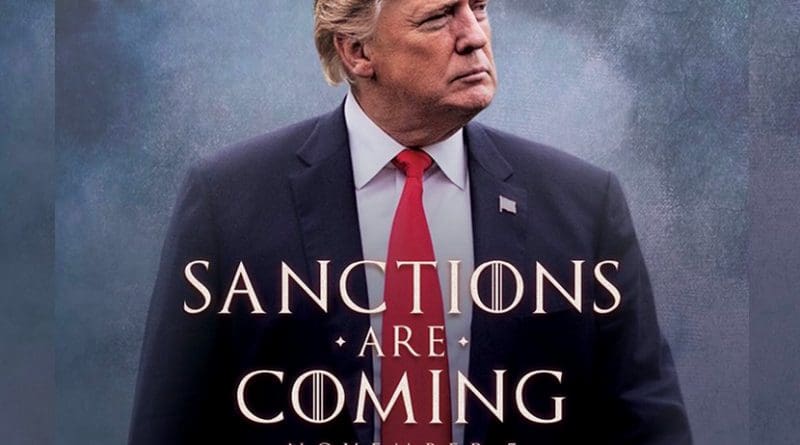Iranian Regime’s Hostility Faces Ultimate Sanctions Test – Analysis
The Trump administration’s crippling new sanctions on Iran are now in place. With a presidential meme to warn Iran of what is coming and daily infographics from the State Department, the US is saying: “Enough.”
The drivers of this round of sanctions are multiple. Primarily, Iran’s perfidious behavior around the world, but especially in Arab lands, has reached a new level of threat that must be pushed back. The Gulf states were never happy with the Obama administration’s negotiations with Iran because of their exclusion from the negotiating process. Arab and specifically Arabian Peninsula voices were ignored. With the Trump administration, however, these voices found a home at the highest levels of the White House, with officials who recognize the serious threat that Iran presents not only in the Middle East, but also in the West from nodes in Latin America, Europe and Southeast Asia.
Another critical driver is the residual nature of recent historical memory in Washington, and elsewhere in the country, concerning the 444 day US-Iran hostage crisis in 1979-1981, plus the Iranian bombing of the US Embassy in Beirut in 1983. Sending a clear message to Tehran about intent and resolve, the second round of sanctions started on the 39th anniversary of the start of the hostage crisis.
In addition, other acts of Iranian hostility — assassinations, bombings, drug trafficking and cyberwarfare — in the past 10 years added to the administration’s current push to strangle Iran’s economy at this historic juncture. Tehran’s ability to use its Ministry of Intelligence and Security (MOIS) networks from Europe to Latin America to Southeast Asia has helped give the Islamic Republic a global reach for terrorism. Moreover, Iranian-made explosively formed penetrators (EFPs) that killed many Americans in Iraq have only added to Iran’s deadly tradecraft and capability.
These EFPs and their toll on American troops is a driver unto itself. At least an estimated 500 US military deaths in Iraq and Afghanistan are directly linked to Iran and its support for anti-American militias. That figure, which in reality is probably much higher given statistical measurement, underscores the controversy surrounding Washington’s now torn-up deal with Tehran. The Iranian-made EFPs first appeared in Iraq in 2005 and for years were the most lethal weapon that US troops faced during the eight-year Iraq War. Unlike the typical improvised explosive devices the US troops encountered, the EFPs used a more sophisticated technology and required more skilled milling to produce. Also known as “shaped” explosives, they used curved copper plates to direct or “shape” the bomb blast. Many EFPs were powerful enough to destroy US Humvees or breach tank hulls.
A final and important driver behind the sanctions is the confrontational discourse within the Beltway and in capitals around the world, including in Europe, about their impact. Reactions to these sanctions come from multiple corners on the world stage, regional outlooks, and divisions within America’s capital.
Naturally, in Washington, advocates for both sides are at each other’s throats trying to one-up each other on the potential impacts and outcomes on the Islamic Republic. America’s dystopia is driving the arguments into a new level of false narratives and loss of expertise, driven by hysteria. Regardless, the bottom line is that the Trump administration is moving forward with anti-Iranian sanctions in order to put the Islamic Republic out of business unless it meets demands that include ending its support for terrorism and its military engagement in Syria, as well as completely halting its nuclear and ballistic missile development.
Reactions to the new round of sanctions moving forward are filled with rhetoric about their impact on average Iranian citizens. Those supporting the Islamic Republic in Europe and elsewhere by not agreeing with the new sanctions are likely to find themselves going along with the program. New alignments in Europe between France, Italy and Germany, and Turkey and Russia, to name just a few, will certainly provoke disdain for the sanctions, but economic interests will trump political goodwill toward the Islamic Republic.
On the other hand, America’s partners against Iran, notably Israel and several Gulf Arab countries, see an opportunity to influence the Islamic Republic’s historical path as an aging leadership begins to die off, while systemic pressures are building and lashing out across the country’s socio-religious landscape. In turn, regime forces are fighting back against this new age of discontent in Iran. Shared mutual interests in terms of Iran’s future means robust support for the Trump administration’s Iran policy is found more outside the US than within. The historical shift in the Middle East and its relationship with the Islamic Republic over Tehran’s behavior is allowing for a coalescence around White House policy.
In the coming months and into next year, the pressure on Iran will continue to draw reactions of various types, including hand-wringing over images and terrified voices that will be projected by the Iranian media. While some may argue that the Tehran government may actually benefit from an excuse to “crack heads” and reorganize the political field, the systemic problems in the theocratic state signal real and significant pressure from the US upon the Islamic Republic. Next year’s 40th anniversary of the start of the 1979 hostage crisis may be quite telling in terms of the metrics of success of the Trump administration’s second round of crippling sanctions.

